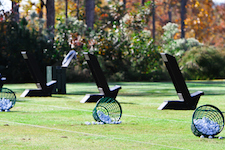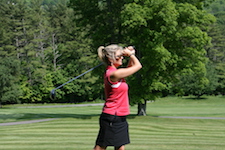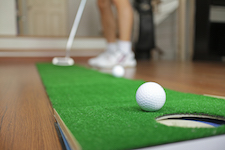HOLE 7:
PRACTICE MAKES PERFECT
Practice makes perfect? Perhaps this is a goal for golf professionals, but for a learning golfer, your goal is to feel more confident and better prepared for a round. As you practice, focus on creating repeating swings and making ball contact. If you feel stuck, join a clinic or schedule a lesson to make adjustments to your swing. In this section, you'll find guidelines and goals that will reinforce the lessons you're taking.
YOUR GUIDE TO EFFECTIVE PRACTICE
Introduction
Practicing your golf swing reinforces the skills covered in your lessons and instills you with the confidence to step fearlessly onto a golf course. Plus, those repetitive motions program your "muscle memory," which will eventually make your golf swings second nature. With each repetition, your swing becomes more fluid, and with enough practice, you'll see improvement.
If you experience a setback, don't be discouraged. Ask for feedback and tips during your next lesson.
Maximize the Practice Range
Since you've set aside the time to practice, it's important to have a clear and efficient practice routine. There are a number of different shots you'll need to advance the ball towards the hole, so a good practice session will include all parts of the game.
Use the 50/50 rule during your first few trips to the practice range. Dedicate half your time to working on the full swing and spend the remainder on your short game. Most golfers don’t get anywhere near this ratio, as the average player spends the majority of their time practicing the full swing. The result is that most people have poor short games (and higher scores).
When you arrive at the practice range, decide how much time you have available and cut that time in half. Make a plan, and get down to business. If you've got 40 minutes during your lunch break, you might start with the full swing for 10 minutes, then spend 20 minutes on the short game, and finish up with another 10 minutes on your full swing. Always end your practice session on a good shot!



Full Swing Practice
TARGET PRACTICE
It's fun to get the ball airborne and watch it fly, but if you're pointed in the wrong direction, you'll quickly feel frustrated. Rather then aimlessly hitting ball after ball, take the extra seconds to set up your shot and aim towards a specific spot. Choose a flag, a sand trap or even the cart picking up range balls. Golf is a target-based game, so get in the habit of always aiming towards something.
Judge your shot by the direction in which it goes, and don't get too concerned about the distance when you're on the practice range. Range balls are constructed for durability rather than performance. The balls you purchase for the golf course are built to perform and should produce better results. Therefore, consider the distances at the range as ball-park figures.
PACE YOURSELF
At the practice range, you're not under the same time constraints that you'll find on the golf course. Take your time and work on the mechanics of your swing, rather then firing off balls in rapid succession.
Develop a PRE-SHOT ROUTINE, which is a series of consistent steps you follow before you hit each shot. The best players in the world use a routine, because it helps eliminate distracting thoughts and sharpens focus prior to hitting the ball. Of course, don't go overboard and take up too much time. Give yourself 15 to 20 seconds to line up to a target, set up to the ball, assess your posture and take a practice swing to help you prepare for a great shot.
CHANGE IT UP
It's easy to get a false sense of confidence on the range - you have multiple attempts to reach your target using the same club from the same position. To simulate a real golf course experience, spend the last part of your full swing practice changing clubs after each shot.
Try starting with a driver hitting the ball off a tee. Switch to a hybrid, then use a 7-iron and conclude with a wedge (aim for a short distance ahead). As you transition to different clubs, adjust your body position while you set up to the ball.



Short Game Practice
The short game consists of swing techniques you'll use when a full swing will overshoot the green. Many ranges have an area dedicated to short game practice, which includes chipping, pitching, sand shots and putting strokes.
The putting green is set up with multiple holes to accommodate several players at once. A well equipped facility has a green with surrounding grassy areas to be used for chipping and pitching, as well as a bunker to practice sand shots. Be aware of signs limiting the green and surrounding areas to putting only. It is also fine to practice your chipping and pitching technique on the driving range.
USE YOUR OWN BALL
Putting is all about feel, and it's better to use the golf balls you're going to use on the course rather than low-quality range balls. Line up three balls in a row and pick a target on the green. Practice putting each one in turn, adjusting your aim and speed to reach the hole. Retrieve the balls after your series of putts and set up for another target. While it's okay for two people to be aiming for the same target, practice towards a hole that's unoccupied if possible.
THE GIMME PUTT
Making a short putt may seem easy, but you'd be amazed how critical they are in determining a final score. Often called a GIMME, because other players can agree to count the shot as a stroke into the hole without being played. After you've worked so hard to get the ball this close, dedicate some of your putting practice to three- and four-foot putts. Most golfers don't spend enough time practicing this commonly missed shot. However, if you find yourself in a friendly team competition, these are the make-or-break putts. Practice making these and you'll become the team hero!
CHIP FROM VARIED CONDITIONS
One of the more difficult techniques for beginners to master is the chip shot, mainly because there are so many ways to hit one! The chip shot is used to get your ball on the green and set yourself up for a short putt into the hole.
If you limit your practice to one club from one spot aiming for a single target, you won't be prepared for the varied situations you'll find on the course. To get the most out of your chipping practice, be sure to include a few shots from the deeper grass. You'll also want to move around the practice green to vary your distance to the hole.
Practice your technique with different wedges as well, and watch where your ball lands and how it rolls. Make adjustments on your next shot to develop a feel for the force needed to reach your target.



Drills Develop Skills
Drills are a great way to keep practice intentional and interesting. There are virtually hundreds of drills you can practice to improve every part of the game, from laying the foundation for your swing to correcting bad habits. Many drills are portable, and there's a wide variety of training aids on the market. Find a few that address your needs and add some fun to your practice sessions.
Grab some household items to create your own drills. A hulu hoop and a few whiffle balls can turn your backyard into a chipping range. Search the Internet or ask your golf instructor to demonstrate drills that can help you develop your swing and make your practice sessions more productive.







